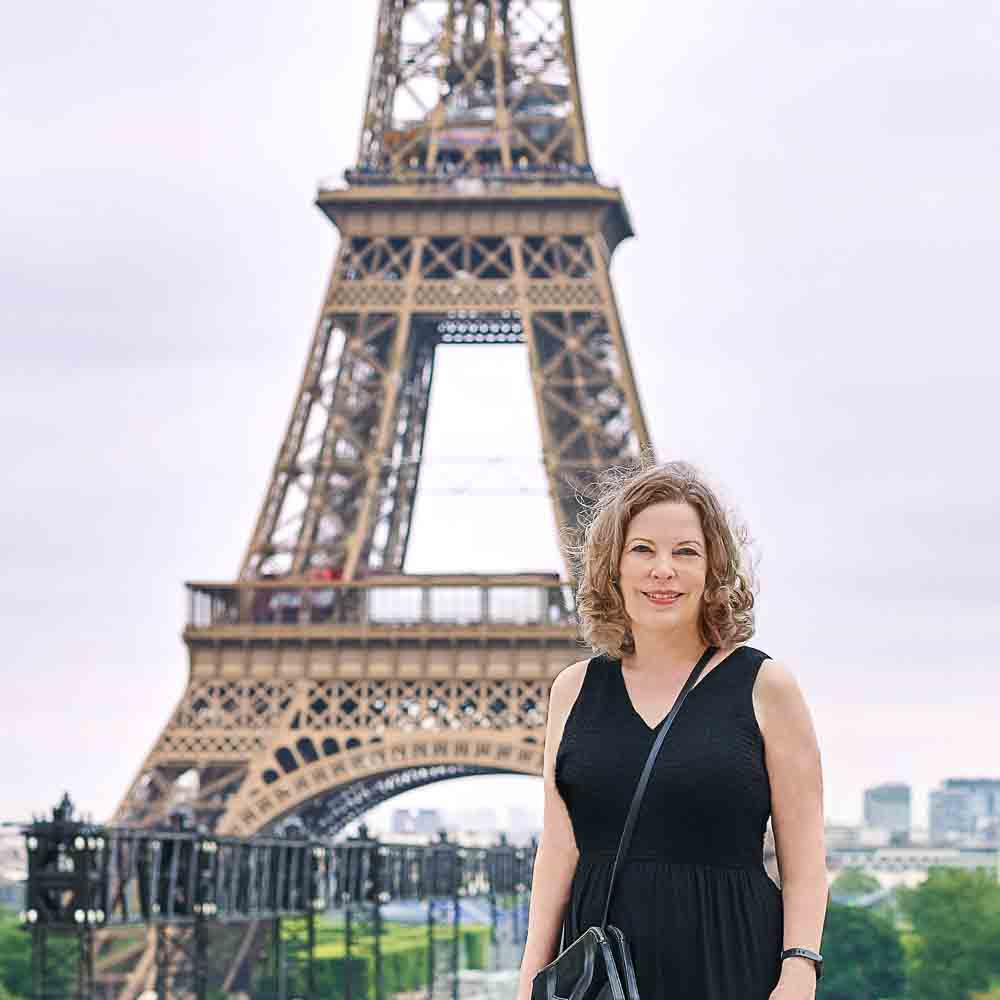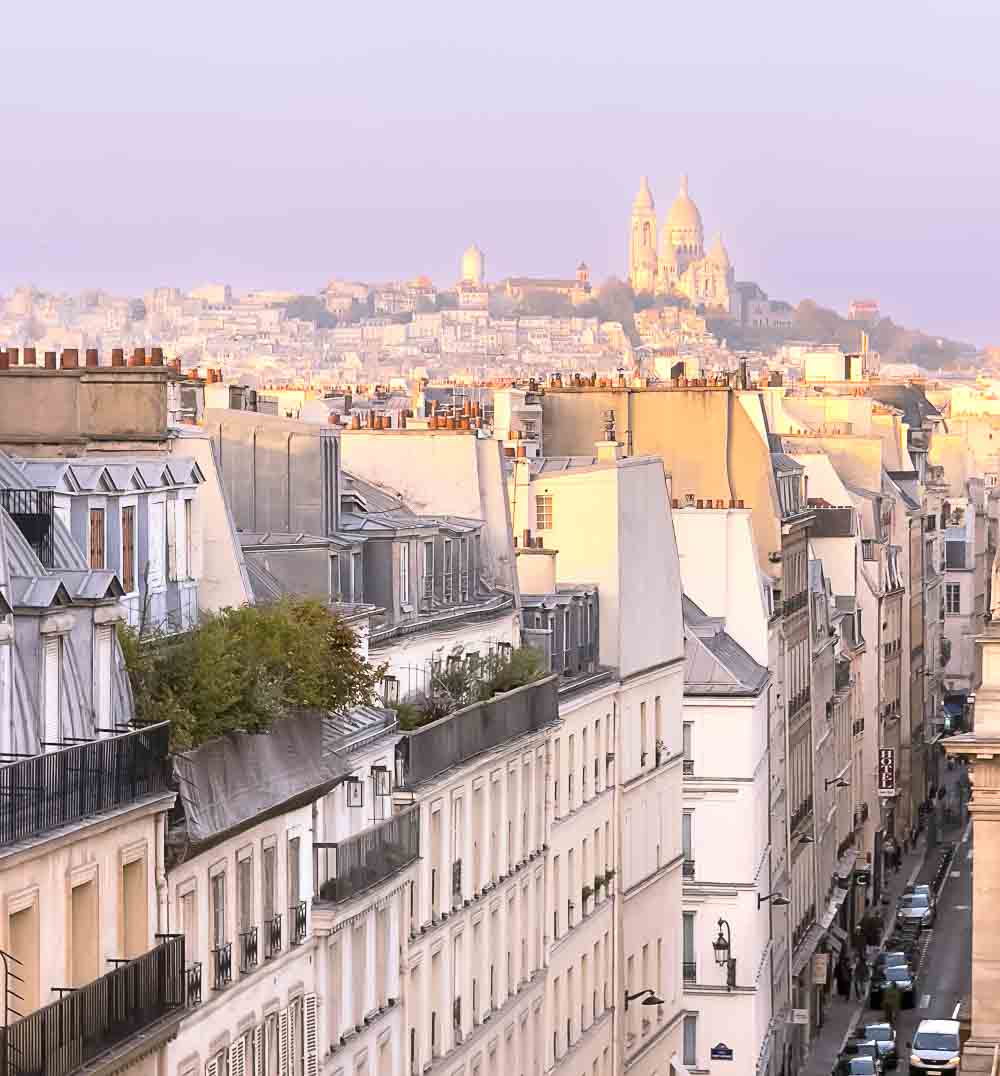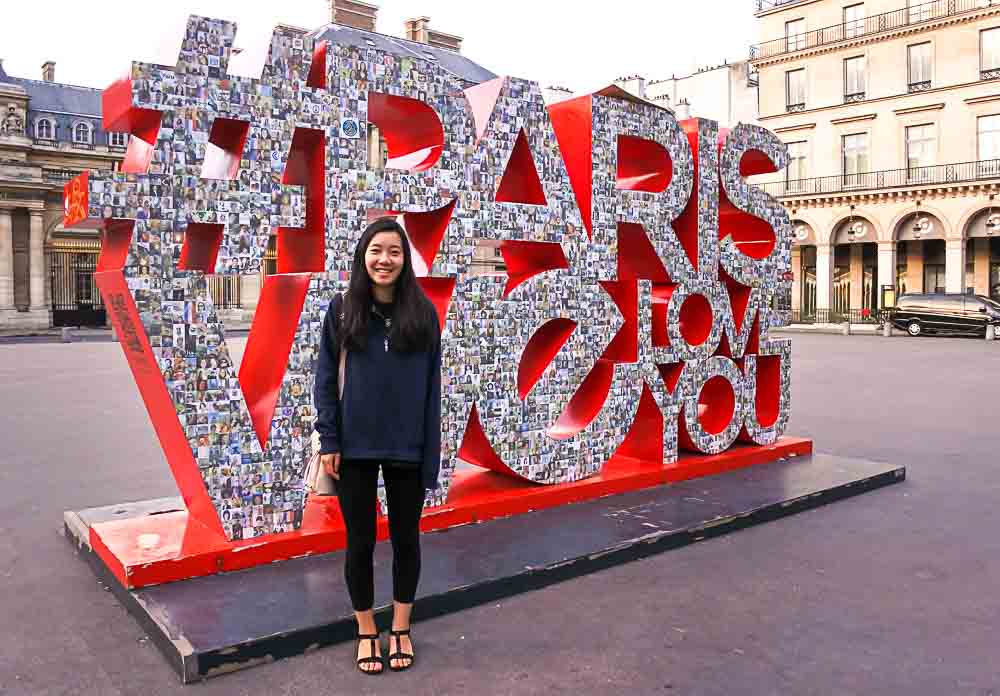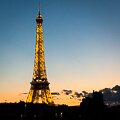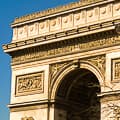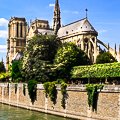The Paris Marathon Route offers you plenty of terrific spots for watching the race along what is considered one of the world's most beautiful courses. If you've previously run or watched this race, please know that there may be a couple of minor changes to the route this year.
Please note: Look for confirmation of all route details closer to April
Just as the Marathon runners get to enjoy views of iconic attractions in the City of Light, you can too. And if you position yourself correctly, you can take photos with these famous landmarks and monuments in the background.
However, if you want to glimpse the Paris Marathon winner, you need be strategic when you choose your viewing location.
In this article, we give you an overview of the Paris Marathon route and a map, and a mile by mile description including locations of famous sights.
Most important, we'll recommend where you can get the best views of the runners, the attractions, and the winner.
See our tips for getting the most from your Paris Marathon experience
Top photo: Paris Marathon runners with Eiffel Tower across the Seine River
Paris Marathon Route: The Big Picture
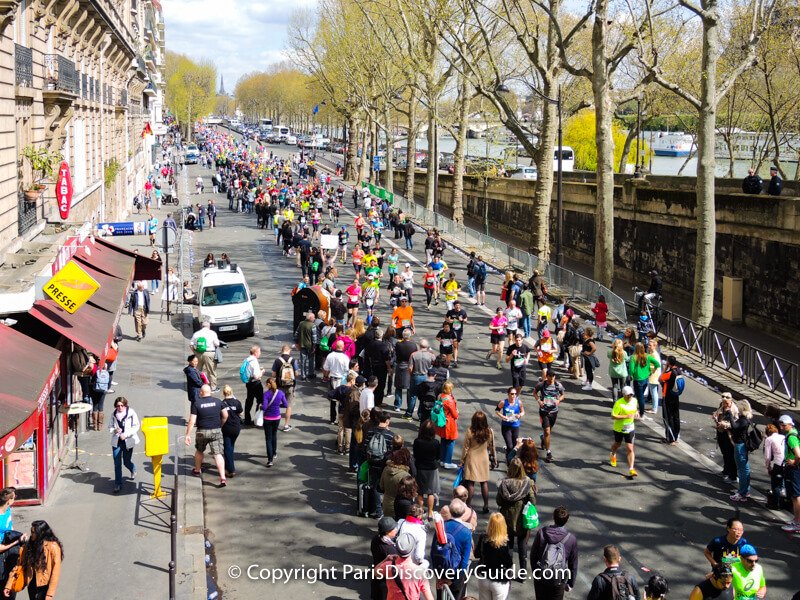
The Paris Marathon route covers a spectacularly scenic course of 26.2 miles (42.195 km) and can easily double as a sightseeing experience. Many music acts and about 250,000 spectators energize and cheer the runners along the way.
Despite a few gradual changes in elevation including a rise in the approach to the finish line, the Paris Marathon's mostly flat route makes for a relatively fast race where you have a good chance of achieving a Personal Best. Winners typically finish in just over two hours, although other participants continue to run through the afternoon.
The race course starts on Champs-Elysées just a few blocks from the Arc de Triomphe. Runners head toward Place de la Concorde, circle around it, and then sweep down Rue de Rivoli past the Tuileries Garden and the Louvre. Rue de Rivoli becomes Rue Saint Antoine as the runners cross the Marais neighborhood and approach Place de la Bastille.
After a fairly short tour through southeast Paris neighborhoods, the course loops around a large swath of Paris's largest park, the picturesque Bois de Vincennes designed by Napoleon III, and then back to Bastille before dipping down and following the picturesque Seine River for a 6-mile stretch past the city's most iconic sights.
At that point, the Marathon route curves up and crosses into the former hunting ground of French kings, Bois de Boulogne, located to the west of the city.
After winding through the park for almost five miles, the route emerges on Avenue Foch just a few hundred yards from the Paris Marathon's finish line and another view of the Arc de Triomphe - the perfect backdrop for photo ops after runners collect their golden Marathon de Paris medals.
Find convenient and affordable hotels for the Paris Marathon
Paris Marathon Route Map
Here is a map showing the Paris Marathon race course for last year (we'll post this year's route once it's official):
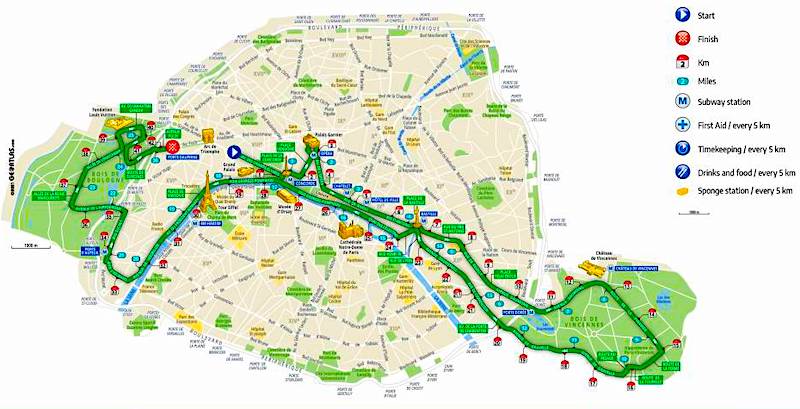
Photo courtesy of Schneider Electric, major Paris Marathon sponsor
A Mile by Mile Paris Marathon Course: Where to View the Race
We give both miles and kilometers for major landmarks below - but keep in mind that both are approximate.
As a reminder: 1 kilometer = .6 mile, 1 mile = 1.6 kilometers, and the official length of a marathon is 26.2 miles, or 42.2 kilometers. Also, the French (and International spelling) for kilometer is kilometre.
Starting Line (Mile/Km 0) to Mile 1 (Km 2): Champs-Elysées
The Paris Marathon route starts near the intersection of Avenue de Champs-Elysées and Rue Marbeuf (south of the avenue) and Rue du Colisée (to the north), as runners head slightly downhill along the broad cobblestone expanse toward the Mile 1 marker at Place de la Concorde where Louis XVI, Marie Antoinette, and many other royals met their fate by guillotine during the French Revolution. Today, a tall Egyptian obelisk makes the famous square easy to spot from a distance.
As you might expect, this first mile of the race is the most crowded as the 57,000 runners pour down Champs-Elysées. Staggered start times from 8:20am - 9:50am keep the congestion from being even worse.
If you want to cheer or photograph the exciting surge of runners, then join the crowd packing the sidewalks. Otherwise, you'll find much better viewing spots beyond the first few miles.
Find out more about what to expect at the Paris Marathon
Mile 1 to Mile 2 (Km 2 to Km 3): Place de la Concord to Palais Garnier to the Louvre
After Concorde, runners turn onto Rue de Rivoli in the 1st arrondissement, usually jammed with traffic but now blissfully car-free and wide enough so that runners (and spectators) have more elbow room.
To the right, runners can see glimpses of the lovely Jardin des Tuileries for a few seconds until they turn left onto Rue de la Paix. They run past the column in Place Vendôme and when they reach the ornate Palais Garnier, they circle it and then run down Avenue de l'Opéra. At Rue Rivoli, they turn to the left and run past the massive Louvre, where the glass pyramids may be visible through groups of spectators on the sidewalk.
Find out more about top Paris attractions
Mile 2 to Mile 3 (Kilometer 3 to 5): Châtelet to Place de la Bastille
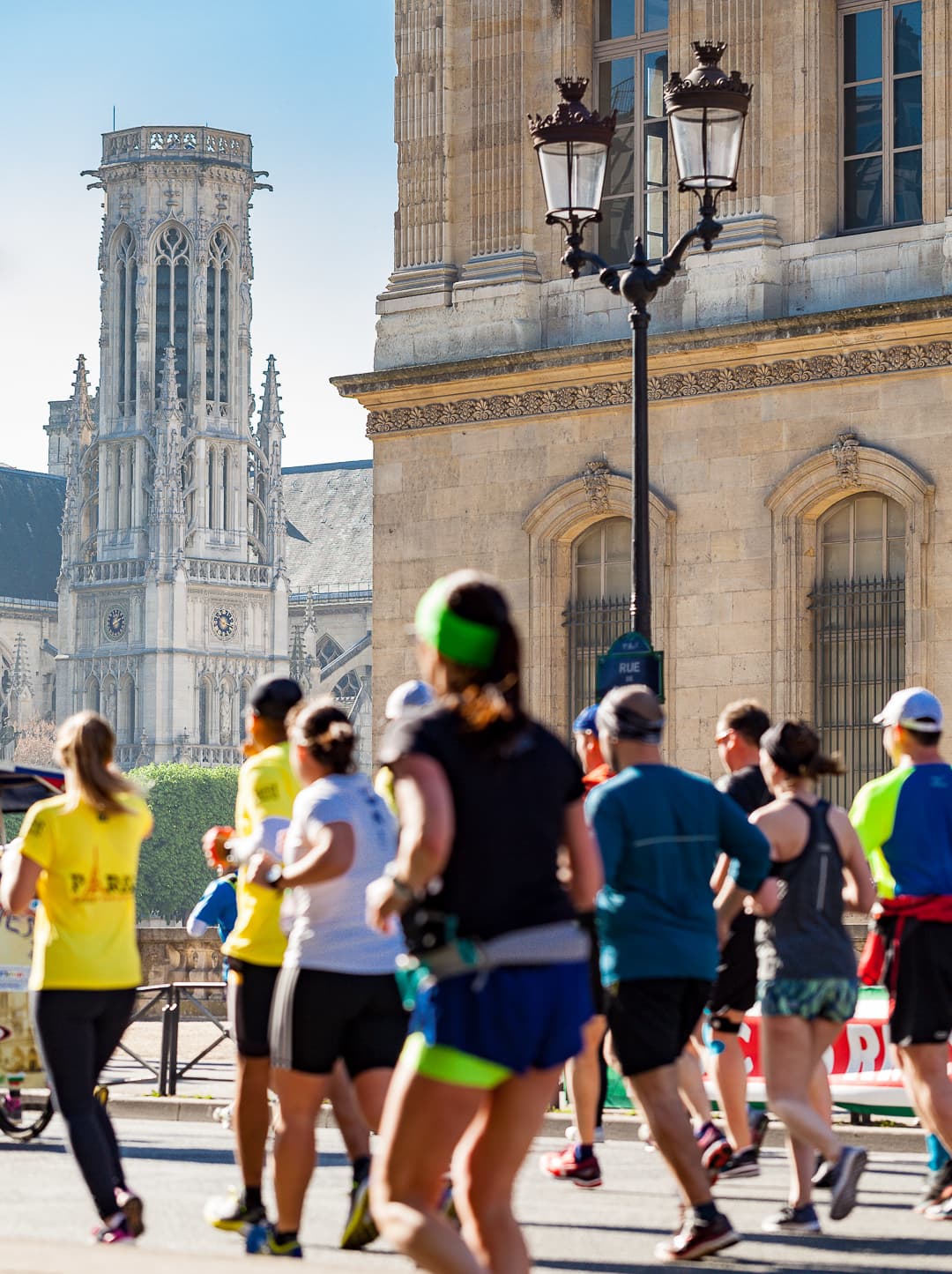
Just after the Mile 2 marker, a tall Gothic tower - all that remains of a 16th century church - comes into site as the Marathon route leaves the 1st arrondissement and crosses into the 4th.
Trendy clothing stores line the north side of Rue de Rivoli.
Just a couple of blocks later, runners will see the massive and ornate Hôtel de Ville (City Hall) on their right and fashionable department store BHV on their left as they enter the chic Marais neighborhood. Just a few blocks farther on the right sits the majestic Saint-Paul Saint-Louis Church.
In another 100 feet, the street name changes to Rue Saint Antoine and almost immediately, the Mile 3 marker appears as the Place de la Bastille and July Column commemorating the destruction of the Bastille prison during the French Revolution come into view.
If you're deciding where to watch the marathon, the Marais section offers several advantages. The number of spectators here is usually far fewer than earlier in the race. You can visit interesting attractions here if you get tired of watching the runners, plus you'll find lots of bakeries and bistros as well as numerous boutiques, parks, and museums waiting to be explored.
Mile 3 to Mile 5 (Kilometer 5 to 6): Place de la Bastille through Eastern Paris
The Marathon route turns left (opposite to the normal traffic direction) around the north side of Place de la Bastille and then heads east on Rue du Faubourg Saint-Antoine through a newly fashionable (and increasingly expensive) swath of the 12th arrondissement, as attested to by all the interesting shops and restaurants along the way.
At Rue de Reuilly, the route turns south and continues through a more residential area. At Place Félix Eboué, named for a leader in Charles DeGaulle's Free French resistance movement during World War II and boasting a lovely fountain at its center, the course turns onto Avenue Daumesnil, the longest road in Paris.
By this point in the race, the fastest runners have moved out ahead of the pack and slower ones have fallen back a bit so the course begins to feel much less crowded. You'll also find far fewer spectators by this point as well.
Mile 5 to Mile 12 (Kilometer 6 to 19): Porte Dorée through Bois de Vincennes
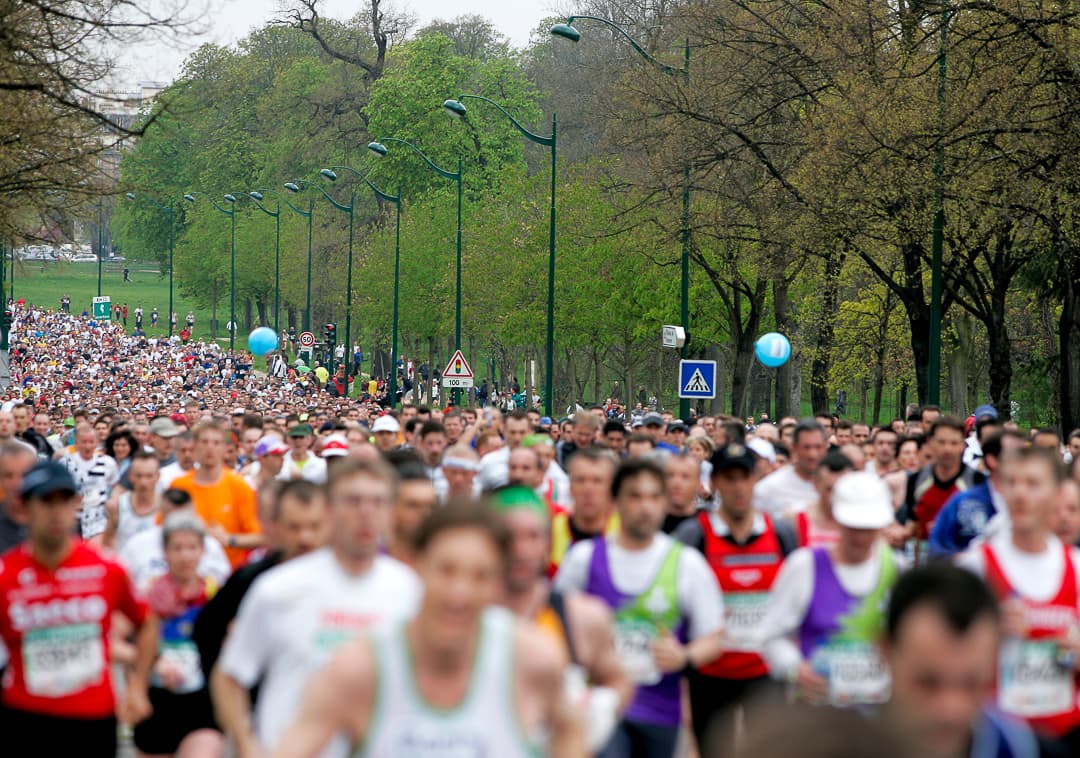
Soon after passing the Mile 5 marker on Avenue Daumesnil, the Marathon route passes the Porte Dorée (Golden Gate) Metro station on the right, and the Palace of the Golden Gate, a huge former exhibition hall built in 1931 and now the site of the Museum of the History of Immigration and a large aquarium featuring tropical fish and other species.
At this point, the route enters the Bois de Vincennes and passes Lake Daumesnil and the Vincennes Zoo, known for its work with endangered species, close to the Mile 6 marker.
Near the Mile 7 marker, runners may be able to glimpse the Château de Vincennes, a massive fortified castle dating back to the 14th century, once the home of French kings and now open for tours.
Despite the park's name, forests cover only about half of it with the rest devoted to four lakes, grassy fields, a pagoda-shaped Buddhist Temple, and all sorts of recreational activities, making it a popular weekend destination for Parisians.
Although some spectators will line the route in Bois de Vincennes, it is never crowded.
Mile 12 to Mile 14 (Kilometer 19 to 22): Rue de Charenton and Back to Bastille
Less than half a mile away from the Mile 12 marker, the Marathon route emerges from Bois de Vincennes onto Rue de Charenton (the race's halfway point), merges back onto a different section of Rue Daumesnil, and skirts around the south side of Place de la Bastille before heading Boulevard Bourdon along the edge of Bassin de l'Arsenal to the Seine.
Runners will begin to notice a few changes in elevation during this stretch - nothing resembling hills, but more like gentle slopes.
For spectators looking for interesting photo angles, this section of the Marathon course offers two interesting opportunities:
- To take photos of the runners from a vantage point about 30 feet above street level, position yourself on the Promenade Plantée, an elevated linear park built on top of an abandoned railway that runs along the north side of this part of Avenue Daumesnil. Easiest place to access it is the staircase at Rue de Lyon and Avenue Daumesnil, not far from Bastille, or Jardin de Reuilly where it drops to street level.
- To photograph the runners as they run past the scenic Bassin de l'Arsenal, position yourself at the south end of it (about 200 feet from the Seine) on Pont Morland. They'll be facing you as they run down Boulevard Bourdon.
Mile 14 to Mile 20 (Kilometer 22 to 32): Seine River & Top Paris Attractions
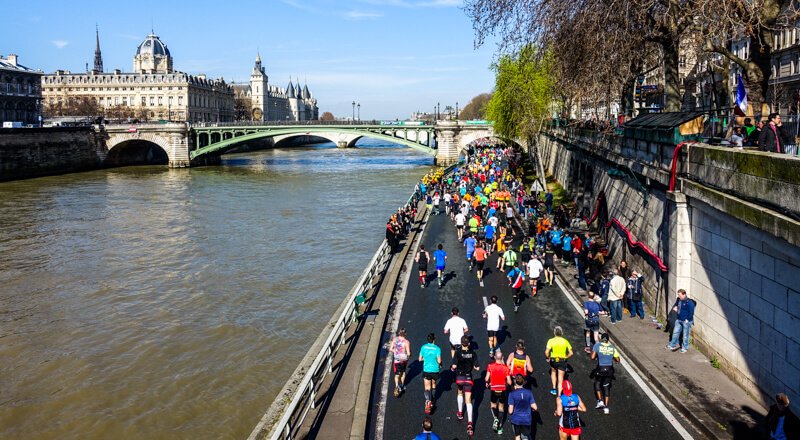
Photo courtesy of Guilhem Vellut
The most scenic part of the Marathon route is the six-mile stretch along the Seine River - except for a series of short tunnels between Pont Neuf and Pont de l'Alma (Miles 16-18), site of the horrific 1997 car crash that took the life of Diana, Princess of Wales, her boyfriend Dodi Fayed, and their driver Henri Paul.
For runners who have become accustomed to the mostly flat course, the worst part about the tunnels, aside from being in them, are the upward slopes coming out of them.
If you're looking for a scenic and mostly uncrowded spot to watch the race with the added bonus of an iconic attraction in the background of your photos, consider positioning yourself in these locations along the Seine:
- Mile 15: Notre Dame Cathedral
- Mile 15: The Conciergerie's medieval towers
- Mile 16: Musée d'Orsay
- Mile 17: Grand Palais - look for the huge glass dome across the river on the Right Bank
- Mile 18: Eiffel Tower, almost directly across from the 30km sign - be sure to look up for a "wow" moment!
- Mile 19: Hot Air Balloon at Parc André Citroen - (only goes up with weather conditions are appropriate)
Mile 20 to Mile 26 (Kilometer 32 to 42): Bois de Boulogne
Soon after Mile 20, the route enters the Boulogne Forest located to the west of Paris, and winds through the woods for almost the remainder of the Marathon. Although slightly smaller than Bois de Vincennes, Bois de Boulogne measures two and a half times larger than Central Park in New York.
Although Bois de Boulogne contains many attractions including Fondation Louis Vuitton's spectacular glass ship-shaped building, most runners consider this the hardest part of the course.
Few spectators appear along this part of the route (after all, why wait here when you can be at the nearby finish line at the Arc de Triomphe instead?), and the massive number of trees seem gloomy and monotonous after a few miles, especially on overcast or rainy days.
Even worse, the elevation begins a slow rise as runners approach the Mile 26 marker.
Mile 26 to Mile 26.2 (Kilometer 42 to 42.2): Avenue Foch to the Finish Line!
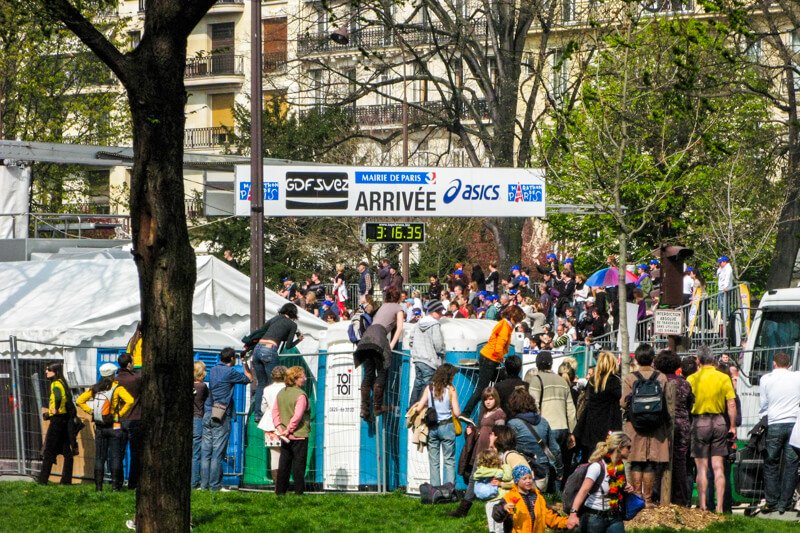
Photo courtesy of Eric Bréchemier
At Mile 26, the route leaves the woods, emerges onto the spacious light-filled Avenue Foch, and rather suddenly ends 200 meters later at the Paris Marathon Finish Line with the Arc de Triomphe rising not far beyond it.
Massive crowds of spectators gather to cheer and applaud the winners as they cross the finish line soon after 10:20am.
Paris Marathon Course from Google Earth in 3D
To see the changing terrain and scenery along the entire Paris Marathon route, watch this 3D simulation from Google Earth:
Best Places to See the Paris Marathon Winner
Logically, the best place to see the Paris Marathon first-place winner should be right at the finish line, right?
Not quite. You'll be competing with cheering crowds 10 people deep for a glimpse of the winner. Your chances of being close enough to actually see the winner cross the finish line, much less get a photo, are slim.
But not to worry. You can still see the winner - just not right at the finish line.
Here's the strategy: Position yourself about a mile before the marathon route's end point, and you can be almost positive that the lead pack of runners includes the winner.
By this point in the race, fatigue from feet pounding on cobblestones, the relative monotony of running through the woods, and the slight incline in this final stretch take a toll. All but the top contenders have fallen behind. Catching up may not be impossible, but it's not likely.
So head a few hundred meters back into Bois de Boulogne and position yourself somewhere between Mile 25 and the edge of the woods where you'll have a great view of the lead group of runners as they fly by. Chances are very good that one of them will be the first to cross the finish line.
More Top Places to Watch Along the Paris Marathon Route
Don't care about seeing the Paris Marathon winner?
In that case, you'll find many other terrific places to watch (and photograph) the race, depending on your goals.
Here's what we recommend:
- To get a sweeping view of the Marathon's start: Position yourself in the vicinity of Place de la Concorde near the Mile 1 Marker; make sure you're in a spot where you can see up Champs-Elysées toward Arc de Triomphe to get the full effect of the crowd running down the famous avenue. Anytime between 8:20am when the Elite group starts and 9:50am when the last group takes off will work.
- To watch for awhile and then enjoy shopping, coffee, and perhaps a museum: Find a spot along the sidewalk in the Marais section of the route between Mile Markers 2 and 3. This area (and all others except for the start and finish line) will not usually be crowded. If you're with your children, explore some of the Marais' many parks and playgrounds, such as the one at Square Leopold-Achille along Rue Payenne.
- To see famous attractions while you watch the race: Anywhere between Mile Markers 15 and 19.
- To watch someone specific cross the finish line: Head to the Arc de Triomphe. Nothing beats seeing your friend, family member, or significant other cross the finish line and appear a short time later with a beautiful Paris Marathon medal! Yes, you'll have to navigate crowds - but the thrill is worth it!
Popular Seine River Cruises
Hotels Close to the Paris Marathon Route
Wondering where to stay and how to choose a hotel for the Paris Marathon? Here are our strategies and suggestions
Want to Save on Your Paris Hotel?
Check our tips on how to find discounts, deals, and bargains for Paris hotels. Whether you're looking for cheap accommodations or want to pay less for luxury, we'll show you how to save on hotels in Paris.
Here are some shortcuts:
- Booking.com: Need last minute reservations? Check out Today Deals on their website
- Trip Advisor: Use their Best Value Deals & save BIG on your Paris hotel
- Priceline: Find the lowest prices on Paris hotels with their Express Deals
More Fun Things to Do & See Before or After the Paris Marathon
You're in Paris! So don't miss the chance to visit some of the city's top attractions:
- Disneyland Paris - Visit everyone's favorite theme park, just a quick train or bus ride from the city - Check ticket availability
- Versailles - Explore the magnificent palace, Hall of Mirrors, and lush gardens this guided tour with transportation from Paris
- Arc de Triomphe Rooftop Terrace - View all of Paris from the top of this iconic monument - Skip the line entry tickets
- Musée d'Orsay - See Impressionist and Post-Impressionist masterpieces in this former train station - Priority tickets
- Seine River Cruise - Enjoy panoramic views of top Paris monuments & landmarks - Illuminations cruise


